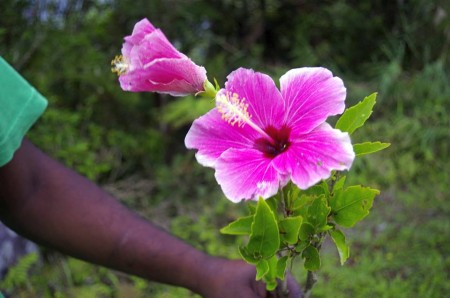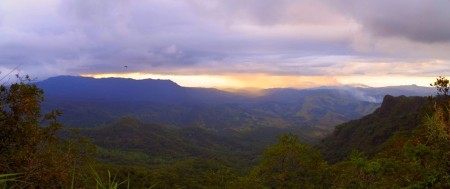- Analysis of Correlations Between Climate and Molecular Adaptive Evolution of Wild Barley with Geographical Information Systems (GIS). Some genes are associated with climatic variables in wild barley, others not so much.
- Molecular Genotyping of Historical Barley Landraces Reveals Novel Candidate Regions for Local Adaption. Latitudinal structuring in northern European barley landraces down to 7 SNPs. Not clear if related to above.
- Morphological and genetic diversity assessment of sesame (Sesamum indicum L.) accessions differing in origin. Not much geographic structure.
- Ploidy and domestication are associated with genome size variation in Palms. Tall coconuts show more variation in genome size than dwarfs.
- Protected areas effectiveness in maintaining viable giant anteater (Myrmecophaga tridactyla) populations in an agricultural frontier. I just wanted to link to a paper on the giant anteater.
- Genetic Diversity in Seedling Populations of Mango. What exactly are “sucking purposes”?
- Diversifying crops for food and nutrition security — a case of teff. Hipsters will save orphan crops.
- Conservation of Rice Genetic Resources for Food Security. In the Philippines genebank, that is.
- Soybean [Glycine max (L.) Merrill]: Importance as A Crop and Pedigree Reconstruction of Korean Varieties. 168 of 178 varieties released in the last 100 years in Korea can be traced to 4 pedigrees.
- In-situ Conservation of wild forest coffee — Exploring the potential of participatory forest management in south west Ethiopia. It’s the communities, stupid.
- Switchgrass Germplasm Resources. Upland and lowland ecotypes, different ploidy levels, latitudinal differentiation, and a national collection at USDA to play with.
- Participatory evaluation of Guinea yam (Dioscorea cayenensis Lam.–D. rotundata Poir. complex) landraces from Benin and agro-morphological characterization of cultivars tolerant to drought, high soil moisture and chips storage insects. 5-15% of over 400 varieties (including duplications) are good for one thing or another.
Hibiscus lost and found
Hibiscus storckii is one of the original, native species hibiscus plants that is a probable ancestor to the modern hibiscus hybrids. It was discovered and named by a botanist visiting the island of Fiji in the 1800s. Expeditions to the island since then have not located any surviving examples of this species of hibiscus still growing on Fiji. The flowers are pink and white, and the bush is small, full, and well-branched. Kew Botanical Gardens in England received cuttings of this species directly from the botanist who discovered it and fortunately has been able to grow it continually ever since.
Yeah, well, the bit about the species not being found in Fiji is happily no longer the case. Because my friend Lex Thomson has just posted this photo on Facebook:

And, to make you (and me) even more envious, here’s where it was found:

I do love it when a wild relative, and a beautiful one at that, turns up in something other than an herbarium specimen. Thanks to Lex and his CSIRO colleague David Bush for letting us bring you the news, and the pix.
The magic of Svalbard
A short distance from the North Pole, there is a Norwegian island called Spitsbergen. On this remote piece of dry land in the very boreal archipelago of Svalbard is the Global Seed Vault, the world’s underground seed store. Within the concrete walls of a warehouse built to withstand even a nuclear war are endangered seeds from around the world. Among them, until four years ago, there were 40 ancient black Peruvian corn grains that a student of agronomy from Cremona — only 16 years old — has now seen fit to make the cornerstone of his company: the agricultural startup of Carlo Maria Recchia.
That sounds easy enough, but Carlo Maria, selected by Coldiretti Giovani as one of Italy’s the most promising young farmers, had to insist to get those seeds, and not a little either. First, with his school, and then through the Ministry of Agriculture. “Then I spent two years multiplying the seeds so I could start to farm,” Carlo told The Food Makers. “Today I produce beer, biscuits, flour, and breadsticks and other products are coming.”
That’s my translation of a piece on StartUpItalia!. Which, yes, I’m afraid insists on the exclamation mark. And, yes, which I’m afraid is utter tosh.
Because there is just no way on earth that Carlo Maria got those black Peruvian maize seeds from Svalbard, Italian Ministry of Agriculture or no Italian Ministry of Agriculture. Only organizations that have deposited seeds in the Svalbard Global Seed Vault can withdraw them, and then only the ones they deposited. And only one organization has ever asked for its seeds back, just a few weeks ago. Making seeds of black Peruvian maize available to random farmers — no matter how young and promising — is just not what Svalbard does.
So I don’t know where Carlo Maria got his seeds. But I can guarantee that it wasn’t Svalbard. Genesys says there are 27 maize accessions from Peru with dark seeds, from the USDA collection. Maybe he got them from there, or from CIMMYT, and given that a lot of that material is safety duplicated in Svalbard, figured he would try to have a little of the stardust rub off on him.
Whatever. I wish him luck, the kid will probably go far. In politics if not farming.
Sourcing the seeds of restoration
Are you involved in the restoration of degraded land? If so, Bioversity International has a survey for you. It’s all because Sustainable Development Goal 15 “affirms the earlier commitments to restore 150 million hectares of degraded landscapes and forest lands by 2020 and at least another 200 million hectares by 2030.” But how to get hold of all the seeds that will be needed? Yeah, not so easy, is it…
Brainfood: Wild maize, Elderberry phenolics, Barley & boron, Land sparing trifecta, Sustainable diets, Chinese apple diversity, Turkish okra diversity, Barcoding yams, Plant diversity levels, Biotic velocity
- Presence of Zea luxurians (Durieu and Ascherson) Bird in Southern Brazil: Implications for the Conservation of Wild Relatives of Maize. Well there’s a turnup for the books.
- Fruit Phenolic Composition of Different Elderberry Species and Hybrids. Some interspecific hybrids have high phenolics levels.
- Diversity in boron toxicity tolerance of Australian barley (Hordeum vulgare L.) genotypes. There’s variation beyond the 4 known boron tolerance loci.
- Agriculture and the threat to biodiversity in Sub-Saharan Africa. Intensification is good for biodiversity, but not yet.
- Land for Food & Land for Nature? The former, according to modelling. But it depends. See above.
- Wildlife-friendly farming increases crop yield: evidence for ecological intensification. Trifecta!
- Is a Cardio-Protective Diet Sustainable? A Review of the Synergies and Tensions Between Foods That Promote the Health of the Heart and the Planet. Yes, but it will take some work.
- Genetic diversity of Malus cultivars and wild relatives in the Chinese National Repository of Apple Germplasm Resources. The varieties from the former Soviet republics and Japan are different to each other and to the canonical European/North American/Chinese material.
- Genetic and phenotypic variation of Turkish Okra (Abelmoschus esculentus L. Moench) accessions and their possible relationship with American, Indian and African germplasms. Turkish okra comes from all over the place.
- DNA barcoding of the main cultivated yams and selected wild species in the genus Dioscorea. 16/21 species I guess is a start.
- Plant responses to climatic extremes: within-species variation equals among-species variation. For a bunch of European grassland plants, within species variation in response to climate was as high as that among species.
- Biotic and Climatic Velocity Identify Contrasting Areas of Vulnerability to Climate Change. Tropical species can’t move fast enough.